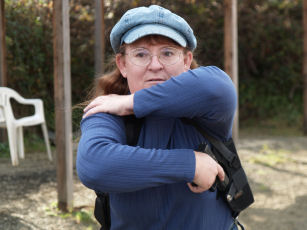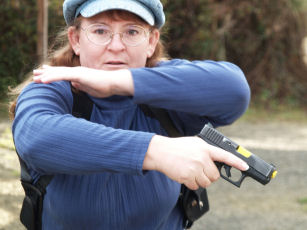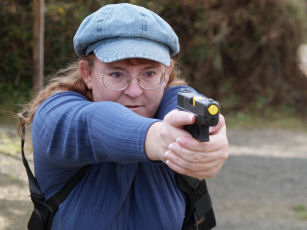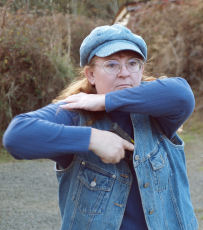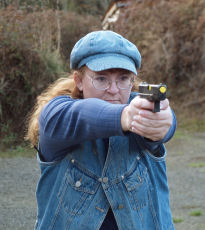Perhaps the most dangerous moment in any firearms class happens when new students begin using their holsters for the first time. But even experienced shooters can fall into some common safety pitfalls when using a holster. These pitfalls, and techniques for avoiding them, are shown in the photo essay below.
Shoulder holster dangers
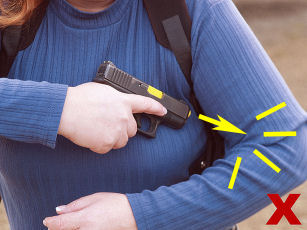 The Danger: The brachial artery in the upper arm can be at risk during the draw from a shoulder holster and again during the reholstering process. An accidental discharge at this point would very likely result in the shooter’s death from rapid blood loss. The Danger: The brachial artery in the upper arm can be at risk during the draw from a shoulder holster and again during the reholstering process. An accidental discharge at this point would very likely result in the shooter’s death from rapid blood loss. |
How to stay safe: the basic draw
| The non-dominant hand slaps the dominant shoulder while the shooter lifts her elbow high out of the way. At the same time, the dominant hand acquires a firing grip on the gun with the finger far outside the trigger guard. |
|
| The elbow remains elevated until the gun has cleared the area, then drops as the non-dominant hand races to obtain a solid grip. Note that the entire area to the left of the shooter will be swept; for this reason, you should always take the far-left shooting position and make sure there’s a solid backstop to that side during practice. If this is not possible on your range, you can practice the shoulder holster drawstroke with a dummy gun at home. |
|
| The trigger finger should not go to the trigger until the sights are on target and the decision to fire has been made. This necessary decision needn’t slow you down, since you can decide whether or not you will fire before you even begin to draw, or at any point during the drawstroke. |
|

How to stay safe: the draw from concealment
| The fastest draw begins with the hand on the holstered gun. Note the arms are overlapped, but not crossed. Although the dominant hand has already acquired a solid grip on the gun underneath the cover garment, the finger is off the trigger and well away from the trigger guard. If there is a retention snap, it may be unsnapped at this point, or you can simply have your fingers in place to unsnap it immediately when needed. |
|
| As the dominant hand begins to retract the gun, the non-dominant hand moves to the opposite shoulder and the shooter begins lifting her elbow at the same time. |
|
| To avoid crossing the brachial artery, the non-dominant elbow lifts high out of the way during the drawstroke. In very close quarters, this same basic motion could easily become an elbow jab to create distance. |
|
| As the gun passes the point of the elbow, the elbow drops and the non-dominant hand comes forward to join the gun hand. Note that the gun has swept everyone and everything to the shooter’s left during the draw. This is unavoidable during an actual encounter, but during practice, every possible step should be taken to avoid endangering others. |
|
| The hands join near the midline as the gun is moving forward. Take care that the non-dominant hand does not travel ahead of the gun during this step. |
|
| The decision to fire has been made, so the finger is on the trigger as soon as the sights align on target. If the shooter did not intend to fire immediately, the finger would remain alongside the frame rather than on the trigger. |
|


 The Danger: The brachial artery in the upper arm can be at risk during the draw from a shoulder holster and again during the reholstering process. An accidental discharge at this point would very likely result in the shooter’s death from rapid blood loss.
The Danger: The brachial artery in the upper arm can be at risk during the draw from a shoulder holster and again during the reholstering process. An accidental discharge at this point would very likely result in the shooter’s death from rapid blood loss.


